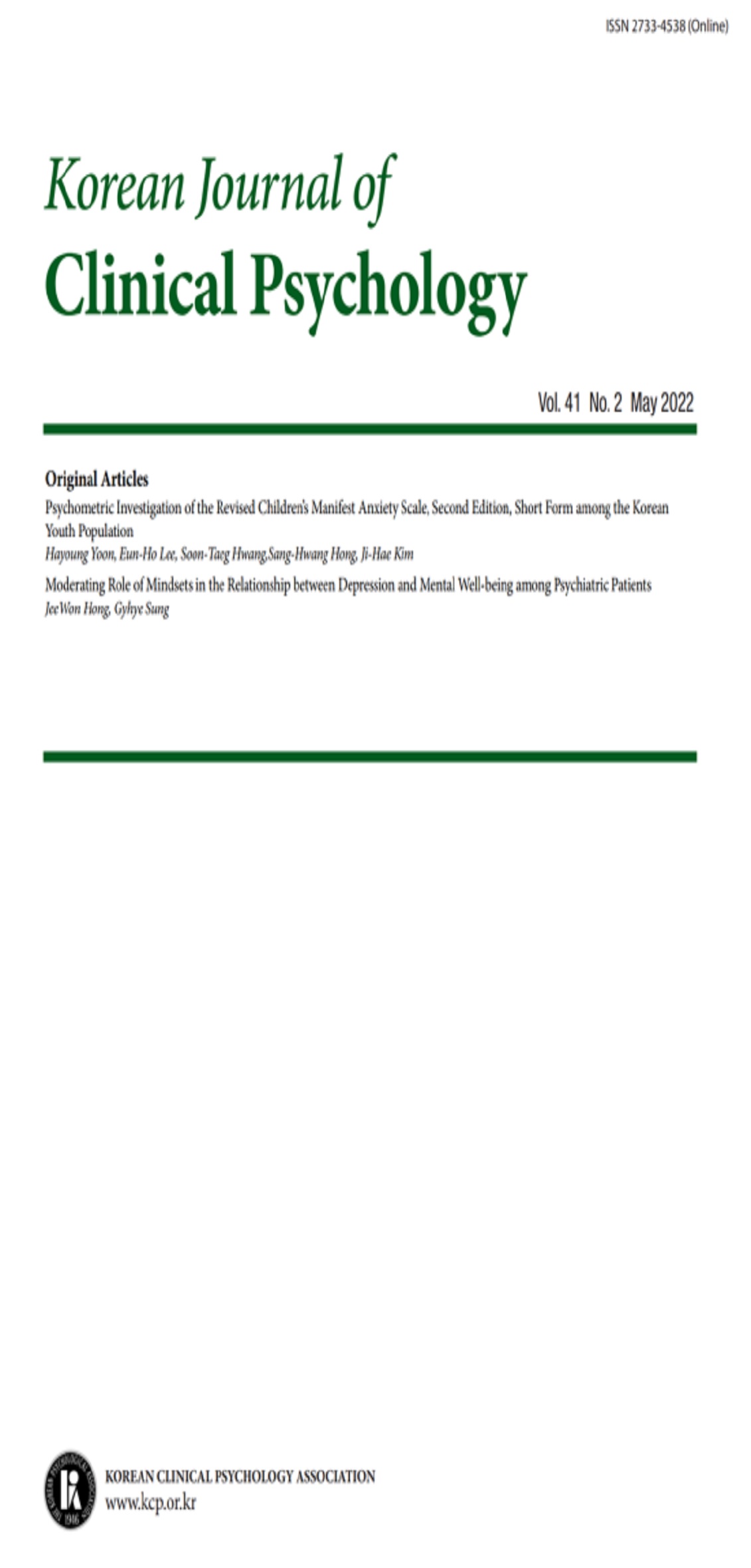open access
메뉴
open access
메뉴 E-ISSN : 2733-4538
E-ISSN : 2733-4538
본 연구의 목적은 걱정이 많은 사람들이 위협적인 상황에서 어떻게 대처하는가를 알아보기 위한 것으로, 일차적 통제 양식과 이차적 통제 양식에 초점을 맞추어 연구하였다. 본 연구의 자료는 대학생 300명에게 얻어졌으며, 측정치에는 걱정증상질문지, 우울증상질문지, 강박 증상질문지와 위협 상황에서의 대처 과정 질문지가 포함되었다. 연구 결과, 걱정 많은 사람들이 걱정이 적은 사람들에 비해 통제 가능한 상황에서는 수동적이고 무기력하게 대처하는 부적응적 일차 통제를 보이고, 통제 불가능한 상황에서는 현실을 인정하고 수용하지 못하는 부적응적 이차 통제를 보였다. 또한, 걱정이 많은 사람들은 걱정이 적은 사람들에 비해 결과의 치명성, 통제 욕구, 통제 의무를 높게 지각하고, 지각된 유능성은 낮았다. 이러한 연구 결과들을 종합하여 결과들의 시사점과 본 연구의 의의, 제한점 및 후속연구에 대한 제언에 관해 논의하였다.
The aim of present study was to investigate the coping process characteristics of high-worriers with a focus on primary control mode and secondary control modes. The subjects were 300 college students, and the measures used were the PSWQ (Penn State Worry Questionnaire), the BDI (Beck Depressive Inventory), the MOCI (Maudsley Obsessional-Compulsive Inventory), and the Coping Process Questionnaire of Threatening Conditions. The results showed that high-worriers exhibited maladjusted primary control modes (passive and helpless coping in a ontrollable condition) and maladjusted secondary control modes (excessive need control in an uncontrollable condition). High-worriers also overestimated ‘fatality of consequences’, ‘control need’, and ‘control duty’ more than low-worriers. Furthermore, high-worriers underestimated their own ‘coping ability’ more than low-worriers. Our results were interpreted in terms of relevant previous studies, and we discussed the limitations of present study and suggestions for future research.
권석만, (2001) 걱정이 많은 사람의 인지적 특성:위협평가와 위협대처에서의 인지적 편향과 파국적 사고경향, 한국심리학회지: 임상
민병배, (2000) 강박사고와 걱정:침투사고 대처과정 및 관련 성격특성에서의 유사점과 차이점,
민병배, (1999) 강박 증상과 걱정의 관계, 한국심리학회지: 임상
민병배, (2000) 강박 증상 및 걱정과 관련된 성격 특성, 한국심리학회지: 임상
유성진, (2000) 걱정이 많은 사람들의 성격 및 인지적,
이영호, (1991) BDI, SDS, MMPI-D 척도의 신뢰도 및 타당도에 대한 연구, 한국심리학회지:임상
조대경, (1985) 강박행동의 객관적 측정에 관 한 일 연구: Maudsley 강박행동목록 표준화, 학생 연구
Ameican Psychiatric Association, (1994) Diagnostic and statistical manual of mental disorders, Author
Barlow, D. H., (1998) Anxiety and its disorders, Guilford Press
Beck, A. T., (1985) Anxiety disorder and phobias: A cognitive perspective, Basic Books
Borkovec, T. D., (1994) The nature, functions, and origins of worry, Wiley
Borkovec, T. D., (1990) The effect of worry on cardiovascular response to phobic imagery, Behaviour Research and Therapy
Borkovec, T. D., (1983) Preliminary exploration of worry: Some characteristics and processes, Behaviour Research and Therapy
Borkovec, T. D., (1995) Perceived functions of worry among generalized anxiety disorder subjects: Distraction from more emotionally distressing topics, Journal of Behavior and Experimental Psychiartry
Craske, M. G., (1989) Qualitative dimensions of worry in DSM-III-R generalized anxiety disorder subjects and nonanxious controls, Behaviour Research and Therapy
Davey, G. C. L., (1993) A comparison of three cognitive appraisal strategies: The role of threat devaluation in problem-focussed coping, Personality and Individual Differences
Davey, G. C. L., (1994) Pathological worrying as exacerbated problem-solving. In G. C. L. Davey & F. Tallis (Eds.), Worrying: Perspectives on theory, assessment and treatment (pp.35-59),
Davey, G. C. L., (1994) Worrying, social problem solving abilities, and social problem-solving confidence, Behaviour Research and Therapy
Davey, G. C. L., (1992) Some characteristics of worrying: Evidence for worrying and anxiety as separate constructs, Personality and Individual Differences
Davey, G. C. L., (1996) Catastrophic worrying as a function of changes in problem-solving confidence, Cognitive Therapy and Research
Dugas, M. J., (1998) Worry themes in primary GAD, secondary GAD, and other anxiety disorders, Journal of Anxiety Disorders
Dugas, M. J., (1998) Generalized anxiety disorder: A preliminary test of a conceptual model, Behaviour Research and Therapy
Frost, R. O., (1993) Compulsivity and superstitiousness, Behaviour Research and Therapy
Heckhausen, J., (1995) A life-span theory of control, Psychological Review
Mathews, A., (1990) Why do worry? The cognitive function of anxiety, Behaviour Research and Therapy
Rothbaum, F., (1982) Changing the world and changing the self: A two-process model of perceived control, Journal of Personality & Social Psycholgy
Salkovskis, P. M., (1998) Psychological approaches to the understanding of obsessional problems, Guil
Shapiro, D. H., (1994) Manual for the Shapiro Control Inventory, Behaviordata
Shapiro, D. H., (1998) Control therapy, John Wiley & Sons
Tallis, F., (1994) The phenomenology of non-pathological worry: A preliminary investigation,
Tallis, F., (1992) Elevated evidence requirements measurement of nonpathological worry, Personality and Individual Differences
